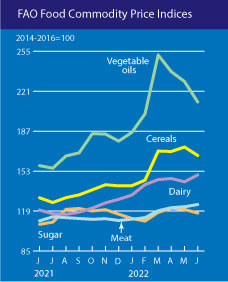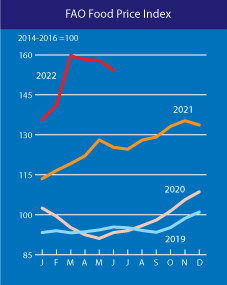In short:
- This wildfire season in Europe started earlier and with more intensity than usual
- Seattle could be hit by a 42-ft tsunami wave within three minutes of an earthquake
- Jackery will offer up to 30% off portable batteries and solar panels on Prime Day (July12-13)
Food prices are falling, but they are still near record highs. The Ukraine war has contributed to the worst food crisis since the 60s
FAO reported that food prices fell for the third consecutive month in June, but remained near March’s record highs. Prices fell because of better crop conditions, higher Russian exports (aided by stolen grain?), and seasonal availability from the northern hemisphere harvest:

Brazil imported record amounts of potassium chloride from Canada in the first half of the year, signaling that farmers will have plenty of fertilizer to nourish crops, boost yields, and expand acres. In 2022, the country is expected to harvest a record 9 million tonnes of wheat.
Increasing extreme weather, coupled with high gas prices, global inflation, and the ongoing pandemic have created the worst food crisis since the 60s. In Somalia (which almost entirely depends on Ukrainian and Russian wheat), Ethiopia, South Sudan, Yemen, and Afghanistan nearly 1 million people are currently facing starvation and death. According to the World Food Program, price increases since March have pushed 47 million more people into acute food insecurity, which means that they can’t eat enough to live and survive, bringing the total number to 345 million. 50 million of which are on the verge of famine. High inflation is hitting poorer people in rich countries, too. Sergei Lavrov said Moscow is ready to negotiate over grain exports, but it is unclear when the negotiations will take place, or if they will yield any results.
Middle East and African countries are tapping EU wheat for the early part of the new season that began this month. Over 1 million tonnes of German new-crop wheat have already been sold to Iran and Africa. The French are expected to replace Algeria’s poor harvest, and export to Morocco.
A rise in fertilizer costs is threatening rice production in parts of Asia at a time when demand is increasing, posing a threat to food security.
Economy, labor market, and supply chain
Abbott baby formula plant reopened after flooding and began producing EleCare. Similac production has not yet resumed at the facility.
The growing economic crisis in Sri Lanka started a series of protests that culminated in the storming of the president’s house. President Gotabaya Rajapaksa will resign on July 13. Here’s a good explainer of the Sri Lanka crisis: How did we get here and what comes next?
The Chinese economy is in decline due to its zero-Covid policies. Despite efforts to revive growth, questions over the pandemic and policy direction remain. Defeating Covid has been made even harder by the fast-moving Omicron variant—and its subvariant, BA.5, which first appeared in China last week—that is slipping through the country’s many defenses.
Deloitte analysts believe that the end of the semiconductor shortage is near. Chip companies have increased capital spending, and much-needed factories are coming online after long construction projects.
US labor shortages could provide an opportunity for ex-prisoners. The National Conference of State Legislatures estimated that barriers facing people with felony convictions contributed to the loss of at least 1.7 million workers from the workforce and a cost of at least $78 billion to the economy in 2014. There are currently more than 11 million open jobs in the US so this labor shortage could open more opportunities to ex-inmates.
According to a new report, a tsunami would cover Seattle’s shoreline under 20 ft (6 m) of water within 3 minutes
If a magnitude 7.5 earthquake struck Puget Sound, a tsunami would inundate Seattle’s shoreline with more than 20 ft (6 m) of water, reaching parts of Bainbridge Island, Elliott Bay, and Alki Point within three minutes. A 42-foot (13-meter) wave could hit the Seattle Great Wheel downtown and reach Lumen Field and T-Mobile Park. This is farther and faster than expected.
What should you do if an earthquake-tsunami strikes? According to the Washington State Department of Natural Resources (the author of the report):
- If the ground is shaking, take cover first somewhere safe.
- When the ground stops moving, particularly if it’s a larger quake, head immediately to higher ground and/or inland from the shoreline.
- If you are near water and you see that water moving back towards the open ocean: run!
- Here are more tips on both earthquakes and tsunamis from us, and a bunch of related blog and forum posts.
Some things you can do to prepare in advance:
- Sign up for earthquake and tsunami warnings. The MyShake app now covers Washington, California, and Oregon. More survival apps here. Here’s how to enable FEMA test alerts on your phone.
- “It is important to be familiar with the natural warning signs of a tsunami,” said the report’s authors. “Time may be too limited to wait for an official signal.”
- Familiarize yourself with official tsunami routes. and be prepared to bug out and/or use those routes at a short notice.
- Here’s our prioritized bug-out bag and IFAK lists.
- And here’s a checklist for beginners, so that can get you started on two weeks of water, food, and other necessities.
If you’re looking for a good tsunami-related movie, The Impossible (2012) is based on a first-hand account of the 2004 Thailand Tsunami. We liked it because, not only it’s a real story, but it also shows how messy and dangerous the aftermath of a tsunami can be.
NEW: A simulation of the impact of a ~7.5-magnitude earthquake on the Seattle Fault.
Tsunami waves could be as high as 42 feet at the Seattle Great Wheel and will reach inland as far as Lumen Field and T-Mobile Park. pic.twitter.com/y44PWHXQtv
— Washington State Dept. of Natural Resources (@waDNR) July 7, 2022
Wildfires, drought, and wet bulb temperatures
Over 3,000 firefighters are fighting hundreds of wildfires in Portugal as temperatures reach 43 C (109 F). Portugal declared a ‘state of contingency’ from July 11-15—one level below calamity and emergency. The country banned the use of farm equipment and outlawed fireworks, as well as restricting public access to forests at risk. Here are pictures of the fires and of how people are helping out. Compared to 2021, which was marked by a year of catastrophic fires worldwide, this fire season in Europe started earlier and with more intensity than usual.
Alaska is experiencing another historic wildfire season as a result of warm springs, low snowpack, and unusual thunderstorm activity. Early in July, there were 2 million acres burned, more than twice the size of a typical Alaska fire season. Over two days in early July, there were about 18,000 strikes in the interior. Since 1990, the number of million-acre fires in Alaska has doubled. Smoke is the most common impact on humans. Wildfires are also burning in California, Colorado, Oregon, Utah, and Arizona. Fires reached a grove of ancient sequoia trees in Yosemite National Park. A 4-foot-tall sprinkler system is protecting the trees from damaging flames and maintains much-needed moisture levels.
There’s been an increase in extreme heat and humidity, measured as ‘wet-bulb temperature‘. A recent study shows that this combination gets dangerous faster than the previously-theorized 35 C. It’s more like a wet-bulb temperature of 31 C (88 F). That would equal 31 C at 100% humidity or 38 C (100 F) at 60% humidity. Even those with access to AC might be affected by the high cost of energy and power outages. Low-cost alternatives, such as swamp coolers, don’t work with wet-bulb temperatures above 21C (70F). Relevant: As heat rises, who will protect farmworkers?
Read here about how this tribe survives in Colorado’s worst drought region with as little as 10% of its hard-won water supply.
Jackery Prime Day deals (July 12-13): 20-30% off portable batteries and solar panels
Jackery gave us a heads up about their planned Prime Day sales. We had reviewed the Jacker Explorer 240 and found it a solid power station, so if you’re looking to get a power station or solar panel, anything from Jackery should be a solid choice.
Some notable sales:
- Jackery Portable Power Station Explorer 500 30% off
- Jackery Portable Power Station Explorer 300 30% off (offer likely valid only as Deal of the Day for half-day or 36 hours)
- Jackery SolarSaga 100W Portable Solar Panel 30% off (offer likely valid only as Deal of the Day for half-day or 36 hours)
- Jackery Solar Generator 2000 Pro (with two 200W solar panels) 25% off
Here are some tips on how to shop for preps online without getting scammed on Prime Day, as well as how to shop for preps without going over budget or buying fantasy gear.
The rest
NYC released a PSA about what to do in the event of a nuclear attack. Officials said that the risk of an attack on NYC is very low, but it is important for New Yorkers to know the steps to stay safe:
A swimmer got infected with a brain-eating amoeba after swimming in Lake of Three Fires in Taylor County, Iowa. Naegleria fowleri is present in warm freshwater across the US, but infection is rare. Here’s how to protect yourself.
The FDA will consider an application for the first birth control pill to be sold without a prescription.


You are reporting the comment """ by on